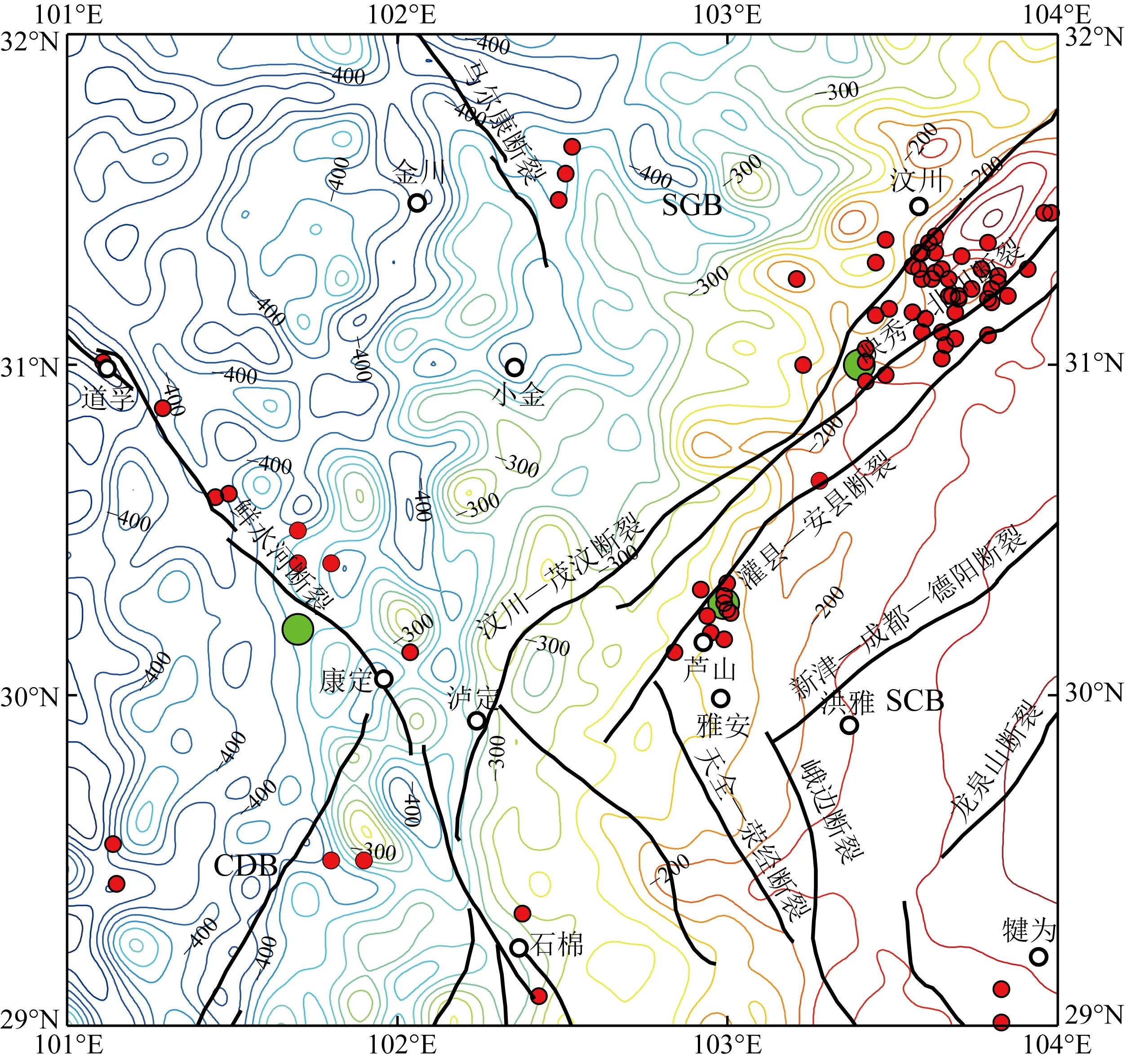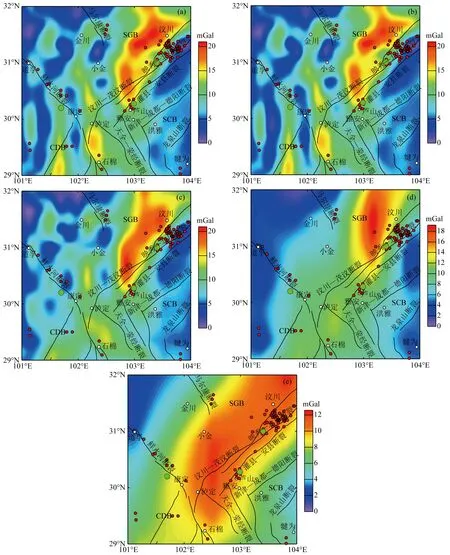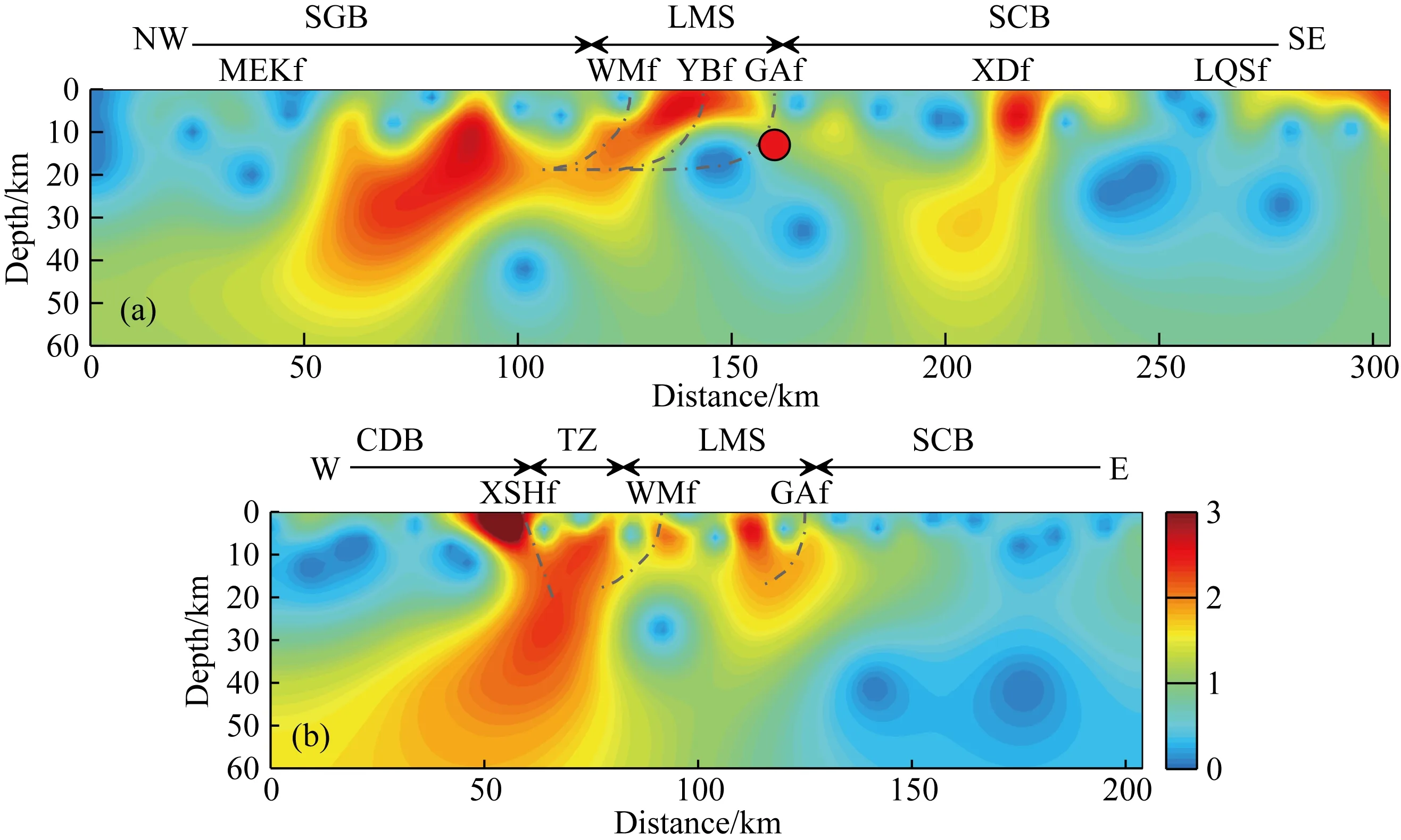芦山—康定地区布格重力异常及其归一化梯度图像的构造物理涵义
2015-06-06玄松柏申重阳谈洪波
玄松柏, 申重阳, 谈洪波
中国地震局地震研究所(大地测量重点实验室), 武汉 430071
芦山—康定地区布格重力异常及其归一化梯度图像的构造物理涵义
玄松柏, 申重阳*, 谈洪波
中国地震局地震研究所(大地测量重点实验室), 武汉 430071
芦山—康定地区是川滇块体、松潘—甘孜块体和华南块体三个块体过渡的“Y”型交汇区,构造变形十分强烈.本文对EGM2008计算的布格重力异常进行1~5阶离散小波变换,得到三方向分量平方和的平方根(HVDM)图像;利用实测剖面布格重力异常数据,得到剖面的布格重力异常归一化总梯度(NFG)图像.结果分析表明:(1) 垂直于龙门山断裂带南段剖面的NFG图像显示推覆构造体前端切割较浅、后端逐步变深至中地壳,说明松潘—甘孜块体在深约10~30 km之间存在滑脱构造,在青藏高原东向挤出和四川盆地的阻挡作用下,造成深、浅部构造差异性运动,形成逆冲推覆的龙门山构造带; (2) HVDM图像和剖面的NFG图像均显示龙门山断裂带西南段与中段和东北段不同,松潘—甘孜块体对四川盆地的逆冲推覆作用沿北东方向具有分段性;(3)雅江—洪雅剖面NFG图像显示鲜水河断裂带和龙门山断裂之间存在高梯度变化带,在鲜水河断裂带下方强变形带不仅在20 km左右东倾至龙门山断裂带前缘,且逐渐近垂直向下伸入至少到下地壳,反映了两大断裂带交汇区域变形作用较强.川滇块体内部和四川盆地内部则显示低值,说明其变形作用较弱.强烈左旋剪切的鲜水河断裂带对芦山—康定地区构造活动具有主要的控制作用.
重力异常; HVDM; 归一化总梯度; 地壳结构; 芦山—康定地区
1 引言
青藏高原在其东缘及东南缘具有巨大的地形梯度带,形成了川滇地块、松潘—甘孜地块和华南地块三个块体过渡的“Y”型交汇区,即芦山-康定地区.该地区是中国大陆构造活动最活跃的地区之一,历史上发生多次强震,地表隆升与构造变形机制仍存在争议.Tapponnier等(1982, 2001)提出高原物质沿主要走滑断裂带(如鲜水河断裂带、红河断裂带)东向挤出模式,东向运动的地壳受到坚硬的四川盆地阻挡而转向东南,GPS测量结果显示了现今连续的旋转弧形左旋走滑运动(Zhang et al., 2004; Shen et al., 2005; Wang et al., 2008; 张培震, 2008).对于龙门山两侧强烈的地形差异和很小地壳缩短量(Zhang et al., 2004),Royden等(1997)提出下地壳流的动力学模式,认为高原东部存在黏性流动的下地壳,受到四川盆地阻挡后,在鲜水河断裂带以南地区形成广阔的下地壳流(Royden et al., 1997; Clark and Royden, 2000; Clark et al, 2005).Bai等(2010)综合地质、GPS和大地电磁观测的结果,根据上地壳与下地壳变形方式的差异,提出双地壳流和边界剪切的模式,即陆陆碰撞在青藏高原东部调整是上地壳刚性块体滑移与下地壳塑性流变的综合效应.张培震(2008)结合现今地表形变和深部结构认为中下地壳的流动是该区强震孕育和发生的驱动力.
龙门山断裂带是多种地球物理场的强烈梯度带(张季生等, 2009; Bai et al., 2010; Zhan et al., 2013; Jia et al., 2014),而鲜水河断裂带则表现为强烈的左旋剪切(Zhang et al., 2004; Shen et al., 2005; Wang et al., 2008; 张培震, 2008),被两大断裂带控制的芦山—康定地区地壳变形机制仍需深入研究.本文利用区域和实测剖面(图1)布格重力异常,计算获得HVDM(各方向成分平方和的均方根)和NFG(归一化总梯度). 综合分析两类图像特征,从重力学角度探索芦山—康定地区地壳结构、地壳变形及其与强震孕育关系.

图1 芦山—康定地区构造背景与重力剖面分布白色线表示块体边界,黑色线表示主要断裂; 三角形为重力剖面测点,其中红色测点由中国地震局地震研究所完成,蓝色测点由中国地震局地球物理研究所完成;白色圆表示主要城镇.SGB,松潘—甘孜块体;SCB,四川盆地;CDB,川滇块体.Fig.1 Tectonic setting in Lushan-Kangding area and distribution of gravity profiles White lines present the boundaries of the blocks, black lines present the major faults. Triangles present the measured stations of the gravity profiles implemented by Institute of Seismology, China Earthquake Administration (red triangles) and Institute of Geophysics, China Earthquake Administration (blue triangles), respectively. White circles indicatethe main town. SGB: Songpan-Garzê block, SCB: Sichuan basin, CDB: Chuan-Dian block.
2 构造背景与布格重力异常
芦山—康定地区是被龙门山断裂带和鲜水河断裂带分隔成的松潘—甘孜块体、川滇块体和四川盆地三大构造单元交汇地区(图1),构造运动同时受控于青藏高原内部物质的侧向挤出和喜马拉雅东构造结俯冲的综合影响(Huang and Zhao, 2006; Li et al., 2008).松潘—甘孜块体是平均海拔高程在4000 m左右的褶皱造山区,分别以龙门山逆冲断裂带和鲜水河走滑断裂带为东边界和南边界(邓起东等, 2010),边界断裂带构造变形复杂,强震频繁发生,21世纪中国大陆的四次主要地震,即2001年昆仑山口西8.1级地震、2008年汶川8.0级地震、2010年玉树7.1级地震和2013年芦山7.0级地震均发生在松潘—甘孜块体边界(He et al., 2014).东边界龙门山断裂带形成于三叠纪中期到晚期(Dong et al., 2013),由一系列推覆构造组成,现今以逆冲滑动为主兼具右旋走滑(Xu et al., 2008),是世界上最显著的大陆地形梯度带之一,从四川盆地约500 m的海拔高程,到松潘-甘孜块体仅约50 km的水平距离,海拔高程最高超过6500 m.南边界鲜水河断裂带亦是川滇块体的东北边界,现今几何形态上呈北东突出的弧形,由不同级别的羽列断层段组成(闻学泽等, 1989),西端与北西西走向的甘孜—玉树活动走滑断裂带相连,南端与南北走向的安宁河活动断裂带相接,以速率约10~12 mm·a-1左旋运动(Zhang et al., 2004; Shen et al., 2005).多种地球物理研究结果揭示松潘—甘孜块体和川滇块体北部地区(小金河断裂以北)下地壳广泛存在低速、高导、低密度体(Wang et al., 2007; Zhang et al., 2009; Bai et al., 2010; Jiang et al., 2012).
从全球重力场模型EGM2008(Pavlis et al., 2008)获得的区域布格重力场特征来看(图2),松潘—甘孜块体表现为较高负异常,达-400 mGal以上,四川盆地较低,仅在-200 mGal以内.1970年以来的5级以上地震多发生在龙门山断裂带和鲜水河断裂带,四川盆地周边的地震活动基本位于布格重力异常高、低转换带,而鲜水河断裂除东南段石棉附近地区外,与四川盆地周边的地震活动存在显著差异.
离散小波变换(DWT)(侯遵泽和杨文采,1997;杨文采等,2001)能够将埋藏不同尺度和深度异常体的重力异常信息较有效分离,我们以离散小波方法为基础,提取其横向、纵向和对角成分平方和的均方根(HVDM)(Oruç, 2014),获得布格重力异常(图2)1~5阶DWT的HVDM图像(图3),图像所揭示深部场源特征和横向不均匀性比重力异常本身(图2)更为清晰.
图3a与图3b基本一致,反映的是物质浅层分布差异性信息.龙门山断裂带5级强震活动基本分布在HVDM高值区域的边缘地带,与鲜水河断裂带上的强震活动分布于较低HVDM区域的特征差异明显.分布于龙门山地区NE-SW走向的HVDM极大值与四川盆地内的HVDM极小值在龙门山断裂带中段和东北段形成显著的高低过渡带,在约31°N处转变为近NS走向,其南端在芦山地震震中附近,龙门山断裂带西南的过渡带不显著,说明龙门山断裂带西南段与中段和东北段在浅层构造上具有显著差异.鲜水河断裂带南端泸定、石棉之间具有较高的HVDM分布,在该区域南端的石棉附近鲜水河断裂带向南和南东延伸转换成安宁河断裂和大凉山断裂(张培震, 2008),鲜水河断裂带在该地区为出露的花岗岩糜棱岩带,表现为强韧性剪切变形(许志琴等, 1992, 2007),体现了该地区在川滇块体北边界构造运动上具有重要的转换作用.

图2 由EGM2008计算的区域布格重力异常(图中数字单位为mGal)重力异常等值线间隔20mGal,红色圆为1970年以来研究区域内5级以上地震,绿色圆从右至左分别为2008年汶川地震、2013年芦山地震和2014年康定地震.Fig.2 Bouguer gravity anomalies derived from EGM2008 in the unit mGal and seismic activity Contour interval is 20 mGal. Red circles present the earthquakes (M>5) since 1970, green circles from right present the 2008 Wenchuan earthquake, the 2013 Lushan earthquake and the 2014 Kangding earthquake, respectively.

图3 布格重力异常1~5阶(对应a—e)HVDMFig.3 The 1st-5th (a—e) level HVDM of Bouguer gravity anomalies
图3c与图3a、3b不同的是,不存在穿过鲜水河断裂带康定段的NS走向的HVDM低值带,体现了随深度的增加芦山—康定地区地下物质性质逐渐一致.图3a、3c反映了松潘-甘孜块体东向挤出,在龙门山地区形成东西向物质密度突变带,可以认为推覆作用的南边界在芦山地震震中附近,芦山震中东北受控于松潘—甘孜块体的东向推挤,西南的龙门山断裂带构造活动受控于地壳的南、南西向运动,与龙门山地区纵横波速比的高低过渡带基本吻合(He et al., 2014),芦山—康定地区地壳结构与龙门山断裂带中段和北段具有较大差异.
图3d反映的是中地壳物质分布差异性信息,HVDM高值呈近NS向分布于甘孜—松潘块体东部,汶川地震及其余震恰恰位于HVDM高低过渡地带,与芦山地震及其余震分布差异显著,可能说明了中地壳变形与发生于同一断裂带的两次地震孕育过程中的作用不同.三大块体交汇区域HVDM基本都在10 mGal左右,说明该地区中地壳的物质密度变化不大,与龙门山中段和东北段具有显著差异.
图3e反映的是下地壳物质分布差异性信息,HVDM高值区域(大于8 mGal)由NE-SW走向在龙门山断裂带南端转变成NS走向,一直延伸到石棉附近,揭示沿龙门山断裂至三大构造块体交汇的芦山—康定地区至石棉附近,下地壳具有相似的物性结构,可能是高温高压致使下地壳物质部分熔融,在上覆岩石的重力荷载下发生流动的结果(Clark et al., 2005; 张培震, 2008; 嵇少丞等, 2008).HVDM高值分布于龙门山断裂带两侧松潘—甘孜块体,松潘—甘孜块体下地壳流受到坚硬的四川盆地阻挡而向两侧分流,泸定、石棉及周边地区的HVDM高值区域与Clark等(2005)向四川盆地南西侧分流的下地壳流和Bai等(2010)给出的北线下地壳流吻合.
3 实测布格重力异常及其归一化总梯度图像
全球重力场模型EGM2008的空间分辨率约9 km(Pavlis et al., 2008),利用模型球谐系数计算的自由重力异常在中国大陆的精度为10 mGal左右(杨金玉等, 2012),且在研究区域与实测自由空气异常存在10 mGal左右的系统误差(付广裕等, 2013).图1中的两条重力探测剖面较EGM2008具有更高空间分辨率,测量的平均点距~3 km,为更精细地刻画芦山—康定地区深部构造背景和变形特征提供可靠资料.
3.1 实测剖面布格重力异常
重力剖面探测的每个测量点分别使用2台相对重力仪(CG-5型)和2台GPS接收机同时同址观测.图1中红色三角形所示剖面呈NW-SE向,垂直于龙门山,西北起自金川,经龙门山西南段的芦山地震震中,东南至犍为,共测量127个点,测量剖面长度约304 km;蓝色三角剖面呈东西向,西起自雅江以东的新都桥附近,经康定跨越鲜水河断裂和龙门山断裂带南段的汶川—茂县断裂和灌县—安县断裂,东至洪雅,共测量90个点,测量剖面长度约204 km.数据处理使用姑咱和成都两个绝对重力值进行控制,两条剖面的平差精度分别为0.0182 mGal和0.0102 mGal.基于测量平差获得的重力值,经高度校正和正常场校正后获得自由空气重力异常,然后利用ETOPO1数字高程数据进行半径为167.7 km的地形校正以及中间层校正(布格板密度取2.67 kg·m-3),进而获得两条剖面的布格重力异常(图4红色三角).
两条剖面布格重力异常总体上均呈现西高东低的总体趋势.金川—雅安—犍为剖面布格重力异常的变化范围在-403~-151 mGal之间,从金川向南东方向呈线性增加,在龙门山(LMS)附近形成突变,其两侧相差近100 mGal;雅江—洪雅剖面布格重力异常的变化范围在-422~-190 mGal之间,从0 km到约50 km,即鲜水河断裂以西的川滇块体维持在-400 mGal左右,鲜水河断裂东侧布格重力异常呈近直线增大,约50 km的剖面长度上增加约130 mGal,四川盆地内部则较稳定地增加.
3.2 归一化总梯度图像
布格重力异常归一化总梯度(NFG)是利用布格重力异常场中的特征点来探测并估计引起重力异常的场源体位置的方法,虽不能直接计算场源体的位置和参数,但在场源体附近NFG解析函数具有收敛性,比重力异常在估计场源体位置和地壳构造变形的强弱方面更具优越性.其基本表达式如下:
(1)
式中GH为重力异常归一化总梯度场,G(x,z)为点(x,z)的总梯度,Gcp(x,z)为深度z的总梯度的平均值,Vxz(x,z)和Vzz(x,z)分别为布格重力异常在点(x,z)水平和垂直方向的一阶导数.
将图3所示的剖面布格重力异常按照3km点距进行线性内插,应用Ardestani(2004)和Dondurur(2005)给出的二维NGF的数值计算方法,根据已有研究(Zengetal., 2002;Ardestani, 2004;Dondurur, 2005;Aghajanietal., 2009)和多次试算,金川—雅安—犍为剖面重力异常有限级数n=61阶,雅江—洪雅剖面有限级数展开n=50阶,向下延拓采用2 km间隔,考虑到可信的GH结果所估计的场源深度与剖面长度之间的关系,即剖面长度应是研究深度的6~10倍(Zengetal., 2002;Ardestani, 2004),两条剖面长度分别为~300km和~200km,其结果反映的可靠场源深度最大在~40km左右.本文仅解释分析地壳部分,更深层的结果作为参考.两条剖面重力异常归一化总梯度如图5所示.两条重力剖面测量时在雅安到洪雅段重合,因金川—雅安—犍为剖面北西-南东走向,雅江—洪雅剖面为东西走向,归算的剖面有所不同,所以,两条剖面重合部分所计算的GH存在一定差异.
图5a为金川—雅安—犍为剖面的布格重力异常归一化总梯度图像.可以看出,图中粗实线勾勒的由松潘-甘孜块体向龙门山方向上地壳存在由深部向浅部延伸的高GH区,一直延伸到整个龙门山地区.松潘—甘孜块体以剖面距离约50km处为界,两侧GH分布截然不同,北西侧上地壳(深度范围约0~30km)GH较小,下地壳(深度>30km)GH则较大,南东侧上地壳0-~10km范围内GH则呈现低—较高—低—较高的分布形态,特别是剖面距离约60~100km,深度约5~40km范围,即等值线为2勾勒的范围,存在由深部向浅部延伸的高GH分布;剖面距离约100km,深度约30km以下区域表现为较低的GH分布.以上结果表明剖面距离约50km的两侧地壳密度结构迥异.较高GH在龙门山地区深约30km向上、向下分成两部分,向上的部分GH比向下部分的大.向上部分由北西侧的汶川—茂县断裂以较低角度向上楔入龙门山至映秀—北川断裂和灌县—安县断裂之间,并向南东向深部延伸,芦山地震震中恰恰位于GH高低变化带上.向下部分以较高的角度深入至龙门山深部.龙门山深部的GH较低.由此可见,龙门山浅部中上地壳部分物质密度分布具有较明显的不均匀性,而深部物质密度分布则较均匀,体现了深浅部变形的差异性.四川盆地内灌县—安县断裂至新津—成都—德阳断裂区域GH值在上地壳较低,中下地壳较高.新津—成都—德阳断裂附近上地壳GH高,且有向北西侧延伸的趋势.龙泉山断裂上地壳GH由低到较高变化,均与断裂带位置基本对应.四川盆地新津—成都—德阳断裂南东侧GH较低,说明该区域地壳呈刚性,变形较弱.

图4 金川—雅安—犍为(a)和雅江—洪雅(b)剖面的高程与布格重力异常蓝色圆圈线为高程,红色三角为布格重力异常.断裂:WMf,汶川—茂汶断裂;YBf,映秀—北川断裂;GAf,灌县—安县断裂;XDf,新津—德阳断裂;LQSf,龙泉山断裂;MEKf,马尔康断裂;XSHf,鲜水河断裂.地块:SGB,松潘—甘孜块体;LMS,龙门山断裂带;SCB,四川盆地;CDB,川滇块体;TZ, 鲜水河与龙门山断裂带间的转换地带.Fig.4 Elevation and Bouguer gravity anomalies of Jinchuan-Ya′an-Qianwei (a) and Yajiang-Hongya (b) profile Blue circle lines present elevation, red triangle lines present Bouguer gravity anomaly. WMf: Wenchuan-Maowen fault, YBf: Yingxiu-Beichuan fault, GAf: Guanxian-An′xian fault, XDf: Xinjin-Deyang fault, LQSf: Longquanshan fault, MEKf: Maerkang fault, XSHf: Xianshuihe fault, SGB: Songpan-Garzê block,LMS: Longmen Shan, SCB: Sichuan basin, CDB: Chuan-Dian block, TZ: Transitional zone between the Xianshuihe fault and the Longmenshan fault.

图5 金川—雅安—犍为剖面(a)和雅江—洪雅剖面(b)的布格重力异常归一化总梯度Fig.5 The normalized total gradient of Bouguer gravity anomalies of Jinchuan-Ya′an-Jianwei (a) and Yajiang-Hongya (b) profile
图5b雅江—洪雅剖面的布格重力异常NFG图像,主要特征是川滇块体下地壳GH较高,鲜水河断裂到龙门山地区上地壳GH分布较复杂,下地壳GH较低,四川盆地内整体GH较低,体现了三个构造单元密度分布迥异的基本特征.西侧上地壳(0-~30km)GH较低,说明川滇块体中上地壳以刚性为主.而~30km以下的下地壳GH较高,表明川滇块体下地壳物质密度异常显著;中部鲜水河断裂地区和龙门山地区GH在上地壳特别是10km上下分布较复杂,说明该地区地壳较为破碎,结构复杂.GH最大值位于鲜水河断裂附近,该地区位于折多山—贡嘎山一带,表明鲜水河断裂是松潘—甘孜块体上地壳物质密度分布的转换带.下地壳GH较低,与金川—雅安—犍为剖面情况基本相同;四川盆地岩石圈呈现刚性特征,且较稳定, 其内部GH整体较低.
4 讨论与结论
青藏高原持续的东向推挤是形成并维持龙门山地区陡峭地形的动力背景(Chenetal., 2013),东部的松潘—甘孜块体上地壳上覆于部分熔融状态的中下地壳之上向东运动,受到坚硬的四川盆地阻挡,形成龙门山局部挤压推覆构造带(TapponnierandMolnar, 1977),表现为推覆在四川盆地之上的彭灌杂岩(Xuetal., 2008;Burchfieletal., 2008).图3a—3c显示的HVDM高值亦揭示龙门山地区是上地壳物质密度变化的过渡带.龙门山地区壳内存在较为坚硬的高导体阻挡(Zhanetal., 2013),东向挤出的上地壳未完全深入龙门山下,由金川—雅安—犍为剖面布格重力异常NGF图像(图5a)可以看出,较高GH在汶川—茂汶断裂下方约20 km处被分成上下两部分.上面的部分物质与组成龙门山断裂带的三条断裂呈叠瓦状推覆于四川盆地之上,在深约20 km处合并成一条韧性剪切带(许志琴等, 1992, 2007; Lou et al., 2009; 徐锡伟等, 2008; 张培震, 2008),推测向上的部分为松潘—甘孜块体的东向推覆体.松潘—甘孜块体不断地推覆与逆冲使得龙门山地区形成韧性变形,造成龙门山地表隆升、地壳增厚(Royden et al., 1997; Clark and Royden, 2000; Clark et al., 2005; Burchfiel et al., 2008; 张培震, 2008).图3a—3c显示芦山地震震中及其东北的断裂带附近的HVDM较高,说明龙门山与两侧地壳物质具有较大差异.松潘—甘孜块体东向推挤,龙门山地区产生向下挤压的物质,使壳内具有物质性质差异的上下两层易产生与地震孕育相关的能量累积.图3c显示的龙门山下方存在较大的HVDM和图5a显示的存在较高的GH揭示了此现象,这与Zhan等(2013)揭示的东向运动物质不会楔入龙门山内部的结论有所不同,上下地壳物质性质的差异可能是青藏高原持续的东向推挤,在受到四川盆地阻挡后上下分异所致,这需要结合其他资料进一步研究.
图3a—3c显示芦山地震震中东北处于HVDM高低转换的梯度带上,西南HVDM较低;同时,两条剖面的布格重力异常NFG图像在龙门山断裂带亦具有显著差异,金川—雅安—犍为剖面(图5a)在龙门山断裂带约深0~30km范围内GH由上至下呈现由高至低分布,雅江—洪雅剖面(图5b)在约深0~30km范围内NFG图像高低差异不明显.松潘—甘孜块体的逆冲推覆作用在龙门山断裂芦山地震震中西南地区有所减弱,可能是受到鲜水河断裂带的强烈左旋剪切效应的影响.龙门山断裂西南段低HVDM与东北段高HVDM具有较明显的差异,即龙门山断裂带具有明显的分段性.四川盆地对青藏高原东向推挤具有阻挡作用,松潘—甘孜块体地壳物质在龙门山断裂带西南段沿四川盆地西南缘向南转向(Clarketal., 2005),从而可能推动了川滇块体顺时针旋转.
穿过鲜水河断裂带的雅江—洪雅剖面NFG图像(图5b)显示,GH高值区域在20km左右具有东倾现象,在上地壳延伸至龙门山断裂带,且近于垂直伸入到上地幔,指示鲜水河断裂带附近地区变形强烈,可能说明该断裂带活动对龙门山断裂带西南段构造活动具有较明显的控制作用.川滇块体的GH较低,与鲜水河断裂带附近的高值GH形成鲜明对比,与地震波成像揭示的缅甸块体在喜马拉雅东构造结相对推挤且俯冲于川滇块体深部(HuangandZhao, 2006;Lietal., 2008)的结果基本一致,体现了鲜水河断裂带对该区构造活动起主要控制作用.GPS观测结果显示倾角近垂直的鲜水河断裂带的左旋速率约10mm·a-1,表现为强烈的左旋剪切作用(许志琴, 1992; 张培震, 2008;Wangetal., 2008),拖动龙门山断裂带西南段向南或南东运动,可能会使西南段右旋走滑强于中段和东北段,从HVDM(图3a—3c)分布来看,龙门山断裂带西南段与中段和东北段亦具有显著差异.
芦山—康定地区地震活动频繁,特别是龙门山断裂带短短5年内相继发生了2008年汶川8.0级地震和2013年芦山7.0级两次强震,以及2014年康定6.3级地震.大量研究表明,汶川地震和芦山地震均与深部滑脱-逆冲型构造密切相关(朱介寿, 2008;Louetal., 2009;Robertetal., 2010).低速的、部分熔融的中下地壳易形成滑脱,使上覆的脆性上地壳向东运动,遇到四川盆地阻挡而形成滑脱-逆冲型构造(朱介寿, 2008).汶川地震是因向东流动的下地壳塑性物质受四川盆地阻挡,在龙门山下堆积使上地壳脆性断裂带形成能量累积引起(朱介寿, 2008; 张培震, 2008);芦山地震震中位于逆冲的密度异常体下方,与玉树地震震中位于垂直于地表的GH高低变化带(玄松柏等,2013)不同,芦山地震震中位于几乎水平的GH高低变化带上(图5a),这与甘孜—玉树断裂带以左旋走滑为主和龙门山断裂以逆冲为主的性质吻合,亦说明芦山地震与玉树地震孕震背景有所不同.与汶川地震不同的是,芦山地震位于泊松比较高的地区(Zhengetal., 2013),即处于中下地壳部分熔融地区,与龙门山断裂带上地壳连成一片(图5b).在鲜水河断裂带附近GH具有向下延伸的特征,下地壳和上地幔顶部附近波速相对较低,且两侧速度差异明显(王椿镛等, 2003),说明鲜水河断裂带向下切割较深,至少延伸到下地壳.因鲜水河断裂带强烈的左旋剪切,结合接收函数结果显示该区处于Moho面深度变化梯度带上(Xuetal., 2007; 张洪双等, 2009),使得川滇块体地壳整体运动对龙门山断裂带西南段上地壳具有带动作用.康定地震虽不是发生在雅江—洪雅剖面上,从甘孜—玉树断裂与鲜水河断裂带均以左旋走滑为主,结合雅江—洪雅剖面GH分布(图5b)来看,康定地震与玉树地震发震机理应相似.
致谢BureauGravimétriqueInternational(BGI)提供了基于全球重力场模型EGM2008计算的布格重力异常数据,中国地震局地球物理研究所提供雅安—洪雅剖面重力异常,在此一并表示感谢.
Aghajani H, Moradzadeh A, Zeng H L. 2009. Estimation of depth to salt domes from normalized full gradient of gravity anomaly and examples from the USA and Denmark.J.EarthSci., 20(6): 1012-1016.
Ardestani E V. 2004. Detection of near-surface anomalies through 2-D normalized full gradient of gravity data.J.EarthSpacePhys., 30(2): 1-6.
Bai D H, Unsworth M J, Meju M A, et al. 2010. Crustal deformation of the eastern Tibetan plateau revealed by magnetotelluric imaging.Nat.Geosci., 3(5): 358-362.
Burchfiel B C, Royden L H, van der Hilst R D, et al. 2008. A geological and geophysical context for the Wenchuan earthquake of 12 May 2008, Sichuan, People′s Republic of China.GSAToday, 18(7): 4-11.
Chen L, Gerya T, Zhang Z J, et al. 2013. Numerical modeling of eastern Tibetan-type margin: Influences of surface processes, lithospheric structure and crustal rheology.GondwanaRes., 24: 1091-1107.
Clark M K, Royden L H. 2000. Topographic ooze: Building the eastern margin of Tibet by lower crustal flow.Geology, 28(8): 703-706.
Clark M K, Bush J W M, Royden L H. 2005. Dynamic topography produced by lower crustal flow against rheological strength heterogeneities bordering the Tibetan Plateau.Geophys.J.Int., 162(2): 575-590.
Deng Q D, Gao X, Chen G H, et al. 2010. Recent tectonic activity of Bayankala fault-block and Kunlun-Wenchuan earthquake series of Tibetan Plateau.EarthSci.Front. (in Chinese), 17(5): 163-178.
Dondurur D. 2005. Depth estimates for slingram electromagnetic anomalies from dipping sheet-like bodies by the normalized full gradient method.PureAppl.Geophys., 162(11): 2179-2195.
Dong S W, Li T D, Lü Q T, et al. 2013. Progress in deep lithospheric exploration of the continental China: A review of the SinoProbe.Tectonophysics, 606: 1-13.
Fu G Y, Zhu Y Q, Gao S H, et al. 2013. Discrepancies between free air gravity anomalies from EGM2008 and the ones from dense gravity/GPS observations at west Sichuan Basin.ChineseJ.Geophys. (in Chinese), 56(11): 3761-3769, doi: 10.6038/cjg20131117.
He C S, Dong S W, Santosh M, et al. 2014. Seismic structure of the Longmenshan area in SW China inferred from receiver function analysis: Implications for future large earthquakes.J.AsianEarthSci., 96: 226-236.
Hou Z Z, Yang W C. 1997. Wavelet transform and multi-scale analysis on gravity anomalies of China.ActaGeophysicaSinica(in Chinese), 40(1): 85-95.
Huang J L, Zhao D P. 2006. High-resolution mantle tomography of China and surrounding regions.J.Geophys.Res., 111: B09305, doi: 10.1029/2005JB004066.
Li C, van der Hilst R D, Meltzer A S, et al. 2008. Subduction of the Indian lithosphere beneath the Tibetan Plateau and Burma.EarthPlanet.Sci.Lett., 274(1-2): 157-168.
Lou H, Wang C Y, Lü Z Y, et al. 2009. Deep tectonic setting of the 2008 WenchuanMS8.0 earthquake in southwestern China—Joint analysis of teleseismic P-wave receiver functions and Bouguer gravity anomalies.Sci.Chin.EarthSci., 52(2): 166-179.
Ji S C, Wang Q, Sun S S, et al. 2008. Continental extrusion and seismicity in China.ActaGeol.Sin. (in Chinese), 82(12): 1644-1667.
Jia S X, Liu B J, Xu Z F, et al. 2014. The crustal structures of the central Longmenshan along and its margins as related to the seismotectonics of the 2008 Wenchuan Earthquake.Sci.Chin.EarthSci., 4457(34): 777-790.
Jiang W L, Zhang J F, Tian T. et al. 2012. Crustal structure of Chuan-Dian region derived from gravity data and its tectonic implications.Phys.EarthPlanet.Int., 212-213: 76-87.
Oruç B. 2014. Structural interpretation of southern part of western Anatolian using analytic signal of the second order gravity gradients and discrete wavelet transform analysis.J.Appl.Geophys., 103: 82-98.
Pavlis N K, Holmes S A, Kenyon S C, et al. 2008. An Earth Gravitational Model to degree 2190: EGM2008.Geophys.Res.Abstr., 10, EGU2008-A-01891.
Robert A, Zhu J, Vergne J, et al. 2010. Crustal structures in the area of the 2008 Sichuan earthquake from seismologic and gravimetric data.Tectonophysics, 491(1-4): 205-210.
Royden L H, Burchfiel B C, King R W, et al. 1997. Surface deformation and lower crustal flow in eastern Tibet.Science, 276(5313): 788-790.
Shen Z K, Lü J N, Wang M, et al. 2005. Contemporary crustal deformation around the southeast borderland of the Tibetan Plateau.J.Geophys.Res., 110: B11409, doi: 10.1029/2004JB003421.
Tapponnier P, Molnar P. 1977. Active faulting and tectonics in China.J.Geophys.Res., 82(20): 2905-2930.
Tapponnier P, Peltzer G, LeDain A Y, et al. 1982. Propagating extrusion tectonics in Asia: new insights from simple experiments with plasticine.Geology, 10(12): 611-616.
Tapponnier P, Xu Z Q, Roger F, et al. 2001. Oblique stepwise rise and growth of the Tibet Plateau.Science, 294(5547): 1671-1677.
Wang C Y, Han H B, Wu J P, et al. 2003. Crustal structure beneath the Songpan-Garze orogenic belt.ActaSeismol.Sin. (in Chinese), 25(3): 229-241.
Wang C Y, Han H B, Wu J P, et al. 2007. Crustal structure beneath the eastern margin of the Tibetan Plateau and its tectonic implications.J.Geophys.Res., 112: B07307, doi: 10.1029/2005JB003873.
Wang Y Z, Wang E N, Shen Z K, et al. 2008. GPS-constrained inversion of present-day slip rates along major faults of the Sichuan-Yunnan region, China.Sci.Chin.EarthSci., 51(9): 1267-1283.
Wen X Z, Allen C R, Luo Z L, et al. 1989. Segmentation, geometric features, and their seismotectonic implications for the Holocene Xianshuihe fault zone.ActaSeismol.Sin. (in Chinese), 11(4): 362-372.
Xu L L, Rondenay S, van der Hilst R D. 2007. Structure of the crust beneath the southeastern Tibetan Plateau from teleseismic receiver functions.Phys.EarthPlanet.Inter., 165(3-4): 176-193.
Xu X W, Wen X Z, Ye J Q, et al. 2008. TheMS8.0 Wenchuan earthquake surface ruptures and its seismogenic structure.Seismol.Geol. (in Chinese), 30(3): 587-629.
Xu Z Q, Hou L W, Wang Z X, et al. 1992. Orogenic Progress of the Songpan-Garze Orogenic Belt of China (in Chinese). Beijing: Geological Publishing House.
Xu Z Q, Li H Q, Hou L W, et al. 2007. Uplift of the Longmen-Jinping orogenic belt along the eastern margin of the Qinghai-Tibet Plateau: Large-scale detachment faulting and extrusion mechanism.Geol.Bull.Chin. (in Chinese), 26(10): 1262-1276.Xu Z Q, Ji S C, Li H B, et al. 2008. Uplift of the Longmen Shan range and the Wenchuan earthquake.Episodes, 31(3): 291-301.
Xuan S B, Shen C Y, Tan H B, et al. 2013. Crustal structure of Riwoqe-Yushu-Maduo profile and YushuMS7.1 earthquake.J.GeodesyGeodyn. (in Chinese), 33(6): 36-40.
Yang J Y, Zhang X H, Zhang F F, et al. 2012. On the accuracy of EGM2008 earth gravitational model in Chinese mainland.ProgressGeophys. (in Chinese), 27(4): 1298-1306, doi: 10.6038/j.issn.1004-2903.2012.04.003.
Yang W C, Shi Z Q, Hou Z Z, et al. 2001. Discrete wavelet transform for multiple decomposition of gravity anomalies.ChineseJ.Geophys. (in Chinese), 44(4): 534-541.
Zeng H L, Meng X H, Yao C L, et al. 2002. Detection of reservoirs from normalized full gradient of gravity anomalies and its application to Shengli oil field, east China.Geophysics, 67(4): 1138-1147.
Zhan Y, Zhao G Z, Unsworth M, et al. 2013. Deep structure beneath the southwestern section of the Longmenshan fault zone and seimogenetic context of the 4.20 LushanMS7.0 earthquake.Chin.Sci.Bull., 58(28-29): 3467-3474.
Zhang H S, Tian X B, Teng J W. 2009. Estimation of crustalVP/VSwith dipping Moho from receiver function.ChineseJ.Geophys. (in Chinese), 52(5): 1243-1252, doi: 10.3969/j.issn.0001-5733.2009.05.013.
Zhang J S, Gao R, Zeng L S, et al. 2009. Relationship between characteristics of gravity and magnetic anomalies and the earthquakes in Longmenshan range and adjacent areas.ChineseJ.Geophys. (in Chinese), 52(2): 572-578.
Zhang Z J, Wang Y H, Chen Y, et al. 2009. Crustal structure across Longmenshan fault belt from passive source seismic profiling.Geophys.Res.Lett., 36(17): L17310, doi: 10.1029/2009GL039580.
Zhang P Z, Shen Z K, Wang M, et al. 2004. Continuous deformation of the Tibetan Plateau from global positioning system data.Geology, 32(9): 809-812.
Zhang P Z. 2008. The present-day tectonic deformation, strain partitioning and deep dynamic progress of the western Sichuan region along eastern margin of the Tibetan Plateau.Sci.Chin.EarthSci. (in Chinese), 38(9): 1041-1056.
Zheng Y, Ge C, Xie Z J, et al. 2013. Crustal and upper mantle structure and the deep seismogenic environment in the source regions of the Lushan earthquake and the Wenchuan earthquake.Sci.Chin.EarthSci., 56(7): 1158-1168.
Zhu J S. 2008. The Wenchuan earthquake occurrence background in deep structure and dynamics of lithosphere.J.ChengduUniv.Technol. (Sci.Technol.Ed.) (in Chinese), 35(4): 348-356.
附中文参考文献
邓起东, 高翔, 陈桂华等. 2010. 青藏高原昆仑—汶川地震系列与
巴颜喀喇断块的最新活动. 地学前缘, 17(5): 163-178.
付广裕, 祝意青, 高尚华等. 2013. 川西地区实测自由空气重力异常与EGM2008模型结果的差异. 地球物理学报, 56(11): 3761-3769, doi: 10.6038/cjg20131117.
侯遵泽, 杨文采. 1997. 中国重力异常的小波变换与多尺度分析. 地球物理学报, 40(1): 85-95.
嵇少丞, 王茜, 孙圣思等. 2008. 亚洲大陆逃逸构造与现今中国地震活动. 地质通报, 82(12): 1644-1667.
王椿镛, 韩渭宾, 吴建平等. 2003. 松潘—甘孜造山带地壳速度结构. 地震学报, 25(3): 229-241.
闻学泽, Allen C R, 罗灼礼等. 1989. 鲜水河全新世断裂带的分段性、几何特征及其地震构造意义. 地震学报, 11(4): 362-372.
徐锡伟, 闻学泽, 叶建青等. 2008. 汶川MS8.0地震地表破裂带及其发震构造. 地震地质, 30(3): 587-629.
许志琴, 侯立玮, 王宗秀等. 1992. 中国松潘—甘孜造山带的造山过程. 北京: 地质出版社.
许志琴, 李化启, 侯立玮等. 2007. 青藏高原东缘龙门—锦屏造山带的崛起——大型拆离断层和挤出机制. 地质通报, 26(10): 1262-1276.
玄松柏, 申重阳, 谈洪波等. 2013. 类乌齐—玉树—玛多剖面地壳结构与玉树7.1级地震. 大地测量与地球动力学, 33(6): 36-40.杨金玉, 张训华, 张菲菲等. 2012. EGM2008地球重力模型数据在中国大陆地区的精度分析. 地球物理学进展, 27(4): 1298-1306, doi: 10.6038/j.issn.1004-2903.2012.04.003.
杨文采, 施志群, 侯遵泽等. 2001. 离散小波变换与重力异常多重分解. 地球物理学报, 44(4): 534-541.
张洪双, 田小波, 滕吉文. 2009. 接收函数方法估计Moho倾斜地区的地壳速度比. 地球物理学报, 52(5): 1243-1252, doi: 10.3969/j.issn.0001-5733.2009.05.013.
张季生, 高锐, 曾令森等. 2009. 龙门山及邻区重、磁异常特征及与地震关系的研究. 地球物理学报, 52(2): 572-578.
张培震. 2008. 青藏高原东缘川西地区的现今构造变形、应变分配与深部动力过程. 中国科学D辑: 地球科学, 38(9): 1041-1056.
朱介寿. 2008. 汶川地震的岩石圈深部结构与动力学背景. 成都理工大学学报(自然科学版), 35(4): 348-356.
(本文编辑 胡素芳)
Tectonic implications of images of Bouguer gravity anomaliy and its normalized full gradient in Lushan-Kangding area
XUAN Song-Bai, SHEN Chong-Yang*, TAN Hong-Bo
KeyLaboratoryofEarthquakeGeodesy,InstituteofSeismology,ChinaEarthquakeAdministration,Wuhan430071,China
The Lushan-Kangding area, which containing the complicated tectonic deformation, is the Y-shaped transitional zone of the Chuan-Dian block, the Songpan-Garzê block and the South China block. The crustal structure and tectonic deformation of this region are quite complicated, which aroused our great interest.We focus on determining the deep mass anomaly in this region, and the HVDM (the square root of the sum of the squares of wavelet detail components in horizontal, vertical and diagonal direction produced by the discrete wavelet transform) and the NFG (the normalized full gradient of Bouguer gravity anomaly) by provided valid approach. In this study, we present the HVDM and the NFG maps, which were inferred from Bouguer gravity anomaly (BGA) data, to investigate the characteristics of crustal structure and tectonic deformationin the Lushan-Kangding area.
We collected the regional BGA derived from EGM2008 in the eastern Tibetan Plateau. The BGA of two measured profiles (Jinchuan-Ya′an-Qianwei profile and Yajiang-Hongya profile) are obtained from the scientific investigation of the 2013 Lushan earthquake. Therefore, the regional BGA and the BGA of the measured profiles had been used to calculate the 1st-5th level HVDM and the 2-D NFG along the two profiles, respectively.
From the HVDM and the NFG maps in this study, we confirmed that: (1) The NFG map of the profile perpendicular to the Longmenshan fault zone showed that the greater NFG extended downward from surface in the Longmenshan fault zone into about 30 km depth in Songpan-Garzê block; (2) The distribution of the HVDM and the NFG all showed that the southwest segment of the Longmenshan fault zone was different from the middle and northeast segments. The greater HVDM located in the middle and northeast segments but not in the southwest segment. Beneath the Longmenshan fault zone,the NFG distribution presented an obvious gradient belt from northwest to southeast as well as from upper crust to middle crust along the Jinchuan-Ya′an-Qianwei profile, and changed not obviously along the Yajiang-Hongya profile; (3) The NFG map of the Yajiang-Hongya profile showed that the high-gradient belts existed in the regions between the Xianshuihe fault zone and the Longmenshan fault zone, and the low NFG value located in the Chuan-Dian block and the Sichuan basin.
According to the characteristics of the HVDM and the NFG images, we concluded that: (1)The front of the nappe structure cut the shallow crust relatively, and extended to the middle crust. Detachment structures presented at about 10~30 km depth beneath the Songpan-Garzê block. For restriction by the Sichuan basin, the eastward extrusion of the Tibetan Plateau was the driving force for the formation of the Longmenshan Thrust Nappe. The crustal activities presented the nappe structure in the shallow crust and the rigid block in the deeper crust beneath the Longmenshan fault zone. (2) The NE trending Longmenshan fault zone appeared segmentation from northeast to southwest. (3) The strong deformation belt beneath the Xianshuihe fault zone not only dipped eastward to the Longmenshan fault zone, but also stretched from surface into lower crust (about 40 km) almost in vertical direction. The above two faults contained the strong deformationin transitional zone. Contrarily, the Chuan-Dian block and the Sichuan basin had weak deformation. The tectonic activities were mainly controlled by the sinistral shearing of the Xianshuihe fault in the Lushan-Kangding area.
Bouguer gravity anomaly; HVDM; Normalized full gradient; Crustal structure; Lushan-Kangding area
10.6038/cjg20151110.
中国地震局地震研究所所长基金(IS201326122),国家自然科学基金(41304060),国家重点基础研究发展计划(2013CB733305)和四川省芦山“4·20”7.0级地震科学考察项目联合资助.
玄松柏,男,1980年生,助理研究员,主要从事重力资料解释与重力反演工作.E-mail:song_bai_whu@163.com
*通讯作者 申重阳,研究员.主要从事地球重力与地壳运动观测方面的研究.E-mail:scy907@163.com
10.6038/cjg20151110
P315
2015-01-12,2015-07-08收修定稿
玄松柏, 申重阳, 谈洪波. 2015. 芦山—康定地区布格重力异常及其归一化梯度图像的构造物理涵义.地球物理学报,58(11):4007-4017,
Xuan S B, Shen C Y, Tan H B. 2015. Tectonic implications of images of Bouguer gravity anomaliy and its normalized full gradient in Lushan-Kangding area.ChineseJ.Geophys. (in Chinese),58(11):4007-4017,doi:10.6038/cjg20151110.
